(完整版)小学英语教学法教程
- 格式:ppt
- 大小:474.00 KB
- 文档页数:168
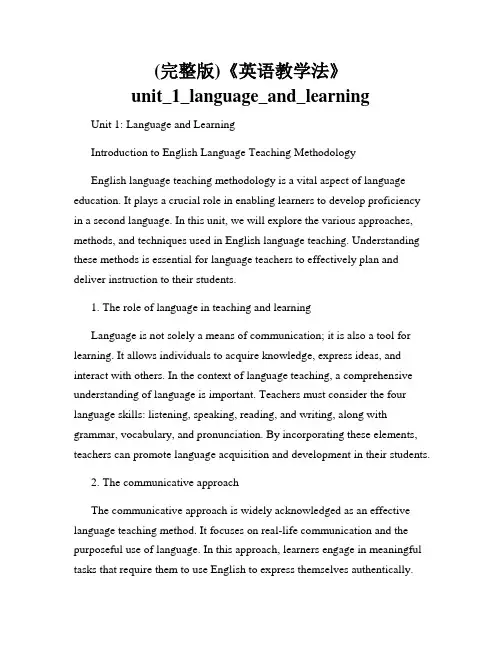
(完整版)《英语教学法》unit_1_language_and_learning Unit 1: Language and LearningIntroduction to English Language Teaching MethodologyEnglish language teaching methodology is a vital aspect of language education. It plays a crucial role in enabling learners to develop proficiency in a second language. In this unit, we will explore the various approaches, methods, and techniques used in English language teaching. Understanding these methods is essential for language teachers to effectively plan and deliver instruction to their students.1. The role of language in teaching and learningLanguage is not solely a means of communication; it is also a tool for learning. It allows individuals to acquire knowledge, express ideas, and interact with others. In the context of language teaching, a comprehensive understanding of language is important. Teachers must consider the four language skills: listening, speaking, reading, and writing, along with grammar, vocabulary, and pronunciation. By incorporating these elements, teachers can promote language acquisition and development in their students.2. The communicative approachThe communicative approach is widely acknowledged as an effective language teaching method. It focuses on real-life communication and the purposeful use of language. In this approach, learners engage in meaningful tasks that require them to use English to express themselves authentically.The communicative approach encourages learners to develop their fluency and accuracy by providing opportunities for interaction and authentic communication.3. The lexical approachThe lexical approach emphasizes the importance of teaching vocabulary and collocations in language learning. It recognizes that grammar and vocabulary are interconnected and that learners must acquire both to communicate effectively. Teachers following the lexical approach prioritize teaching high-frequency and useful vocabulary, as well as the collocations and phrases associated with them. By developing a strong lexical repertoire, learners can enhance their language proficiency and understanding.4. Task-based language teachingTask-based language teaching (TBLT) is a learner-centered approach that focuses on the completion of meaningful tasks. In TBLT, learners are presented with a task that requires the use of language to accomplish a specific goal. These tasks can be simulations of real-life situations or problem-solving activities. By engaging in these tasks, learners develop their language skills while also achieving the task objective. TBLT promotes both language acquisition and the development of critical thinking and problem-solving skills.5. Technology-enhanced language teachingTechnology has revolutionized language teaching and learning. It provides teachers and learners with access to an array of digital resources and tools. Technology-enhanced language teaching encompasses the use ofeducational software, online platforms, multimedia materials, and interactive activities. It enhances learner engagement and provides opportunities for independent learning. Integration of technology in language teaching opens up new possibilities for personalized and adaptive instruction.ConclusionEnglish language teaching methods continually evolve to meet the needs of diverse learners. It is essential for language teachers to keep abreast of current approaches and techniques to maximize instructional effectiveness. The approaches discussed in this unit, including the communicative approach, lexical approach, task-based language teaching, and technology-enhanced language teaching, provide teachers with valuable frameworks to deliver comprehensive and engaging language instruction. By applying these methods, language teachers can foster language learning and promote language proficiency development in their students.(Word count: 585)。
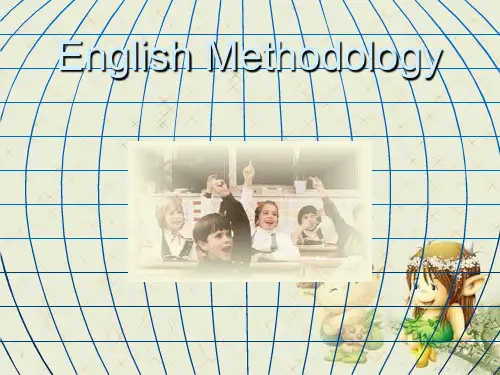
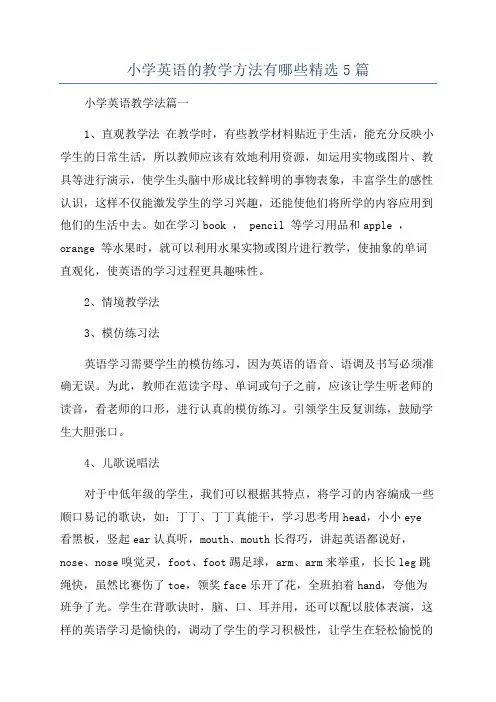
小学英语的教学方法有哪些精选5篇小学英语教学法篇一1、直观教学法在教学时,有些教学材料贴近于生活,能充分反映小学生的日常生活,所以教师应该有效地利用资源,如运用实物或图片、教具等进行演示,使学生头脑中形成比较鲜明的事物表象,丰富学生的感性认识,这样不仅能激发学生的学习兴趣,还能使他们将所学的内容应用到他们的生活中去。
如在学习book , pencil 等学习用品和apple ,orange 等水果时,就可以利用水果实物或图片进行教学,使抽象的单词直观化,使英语的学习过程更具趣味性。
2、情境教学法3、模仿练习法英语学习需要学生的模仿练习,因为英语的语音、语调及书写必须准确无误。
为此,教师在范读字母、单词或句子之前,应该让学生听老师的读音,看老师的口形,进行认真的模仿练习。
引领学生反复训练,鼓励学生大胆张口。
4、儿歌说唱法对于中低年级的学生,我们可以根据其特点,将学习的内容编成一些顺口易记的歌诀,如:丁丁、丁丁真能干,学习思考用head,小小eye 看黑板,竖起ear认真听,mouth、mouth长得巧,讲起英语都说好,nose、nose嗅觉灵,foot、foot踢足球,arm、arm来举重,长长leg跳绳快,虽然比赛伤了toe,领奖face乐开了花,全班拍着hand,夸他为班争了光。
学生在背歌诀时,脑、口、耳并用,还可以配以肢体表演,这样的英语学习是愉快的,调动了学生的学习积极性,让学生在轻松愉悦的气氛中学习,使他们感到学习不再是一种负担,而是一种乐趣。
教学有法,教无定法,贵在得法。
我觉得小学生学英语就像学游泳一样,必须让学生泡在水中、潜到水里去,这样他最后才能成为一个熟练的游泳者,自在游泳乐在其中。
因此,英语教师应激发学生的学习兴趣,给学生尽量多地创造听、说、练的机会,让学生在动中学,学中乐,使之获得语言知识技能,真正达到轻松学英语、轻松用英语的目的。
5、表演法如在“In the morning”这一单元后,我们的表演要求就是:把一天从早晨醒来到上学这一阶段的生活用英语表演出来。
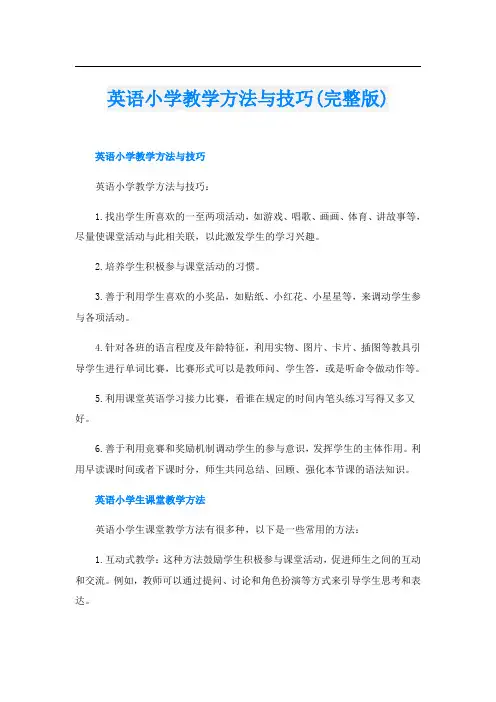
英语小学教学方法与技巧(完整版)英语小学教学方法与技巧英语小学教学方法与技巧:1.找出学生所喜欢的一至两项活动,如游戏、唱歌、画画、体育、讲故事等,尽量使课堂活动与此相关联,以此激发学生的学习兴趣。
2.培养学生积极参与课堂活动的习惯。
3.善于利用学生喜欢的小奖品,如贴纸、小红花、小星星等,来调动学生参与各项活动。
4.针对各班的语言程度及年龄特征,利用实物、图片、卡片、插图等教具引导学生进行单词比赛,比赛形式可以是教师问、学生答,或是听命令做动作等。
5.利用课堂英语学习接力比赛,看谁在规定的时间内笔头练习写得又多又好。
6.善于利用竞赛和奖励机制调动学生的参与意识,发挥学生的主体作用。
利用早读课时间或者下课时分,师生共同总结、回顾、强化本节课的语法知识。
英语小学生课堂教学方法英语小学生课堂教学方法有很多种,以下是一些常用的方法:1.互动式教学:这种方法鼓励学生积极参与课堂活动,促进师生之间的互动和交流。
例如,教师可以通过提问、讨论和角色扮演等方式来引导学生思考和表达。
2.多媒体教学:多媒体教学可以利用图像、声音、视频等多种形式来呈现教学内容,增强学生的感官体验和学习兴趣。
教师可以利用多媒体课件、教学视频等资源来辅助教学。
3.游戏化教学:这种方法将游戏元素引入教学中,让学生在游戏中学习和掌握知识。
例如,教师可以设计一些拼图、填空、谜语等小游戏来帮助学生记忆单词、语法和句型等。
4.合作学习:这种方法鼓励学生之间合作学习和交流,培养学生的团队合作精神和沟通能力。
教师可以组织小组讨论、角色扮演、游戏竞赛等活动来促进合作学习。
5.创造语言环境:这种方法通过创造真实的语言环境,让学生在实际场景中学习和使用英语。
例如,教师可以组织学生参加英语角、英语俱乐部等活动,让学生在真实的语言环境中与外国人交流和互动。
以上是一些常用的英语小学生课堂教学方法,教师可根据学生的特点和需求选择适合的方法进行教学。
小学英语教学方法有哪几种以下是小学英语教学方法:1.情景法。
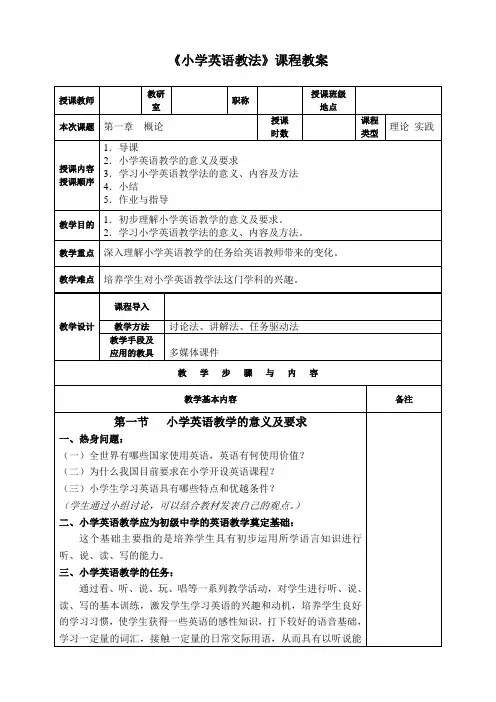
《小学英语教法》课程教案授课教师教研室职称授课班级地点本次课题第一章概论授课时数课程类型理论实践授课内容授课顺序1.导课2.小学英语教学的意义及要求3.学习小学英语教学法的意义、内容及方法4.小结5.作业与指导教学目的1.初步理解小学英语教学的意义及要求。
2.学习小学英语教学法的意义、内容及方法。
教学重点深入理解小学英语教学的任务给英语教师带来的变化。
教学难点培养学生对小学英语教学法这门学科的兴趣。
教学设计课程导入教学方法讨论法、讲解法、任务驱动法教学手段及应用的教具多媒体课件教学步骤与内容教学基本内容备注第一节小学英语教学的意义及要求一、热身问题:(一)全世界有哪些国家使用英语,英语有何使用价值?(二)为什么我国目前要求在小学开设英语课程?(三)小学生学习英语具有哪些特点和优越条件?(学生通过小组讨论,可以结合教材发表自己的观点。
)二、小学英语教学应为初级中学的英语教学奠定基础:这个基础主要指的是培养学生具有初步运用所学语言知识进行听、说、读、写的能力。
三、小学英语教学的任务:通过看、听、说、玩、唱等一系列教学活动,对学生进行听、说、读、写的基本训练,激发学生学习英语的兴趣和动机,培养学生良好的学习习惯,使学生获得一些英语的感性知识,打下较好的语音基础,学习一定量的词汇,接触一定量的日常交际用语,从而具有以听说能力为主的初步交际能力,同时在英语学习中受到良好的思想品德教育,个性得到健康和谐的发展。
四、小学英语教学对英语教师有哪些要求?教师要结合学生的年龄、心理特点创造性地使用课本。
这就要求教师应从教授语言、发展智力、培养非智力因素三方面努力,搞好英语的教与学活动,运用恰当的教学方法,通过小学英语课堂教学活动的趣味性、直观性、实践性使小学生爱学,会学,主动学。
第二节学习小学英语教学法的意义、内容及方法一、学习小学英语教学法的意义:(一)语言教学既是一门科学,又是一门艺术,对不同阶段、不同目的的学习者应该使用不同的教学方法。
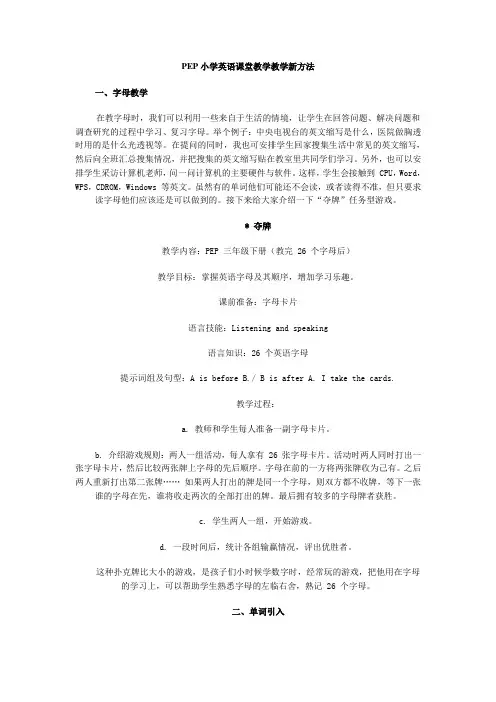
PEP小学英语课堂教学教学新方法一、字母教学在教字母时,我们可以利用一些来自于生活的情境,让学生在回答问题、解决问题和调查研究的过程中学习、复习字母。
举个例子:中央电视台的英文缩写是什么,医院做胸透时用的是什么光透视等。
在提问的同时,我也可安排学生回家搜集生活中常见的英文缩写,然后向全班汇总搜集情况,并把搜集的英文缩写贴在教室里共同学们学习。
另外,也可以安排学生采访计算机老师,问一问计算机的主要硬件与软件。
这样,学生会接触到 CPU,Word,WPS,CDROM,Windows 等英文。
虽然有的单词他们可能还不会读,或者读得不准,但只要求读字母他们应该还是可以做到的。
接下来给大家介绍一下“夺牌”任务型游戏。
* 夺牌教学内容:PEP 三年级下册(教完 26 个字母后)教学目标:掌握英语字母及其顺序,增加学习乐趣。
课前准备:字母卡片语言技能:Listening and speaking语言知识:26 个英语字母提示词组及句型:A is before B./ B is after A. I take the cards.教学过程:a. 教师和学生每人准备一副字母卡片。
b. 介绍游戏规则:两人一组活动,每人拿有 26 张字母卡片。
活动时两人同时打出一张字母卡片,然后比较两张牌上字母的先后顺序。
字母在前的一方将两张牌收为己有。
之后两人重新打出第二张牌……如果两人打出的牌是同一个字母,则双方都不收牌,等下一张谁的字母在先,谁将收走两次的全部打出的牌。
最后拥有较多的字母牌者获胜。
c. 学生两人一组,开始游戏。
d. 一段时间后,统计各组输赢情况,评出优胜者。
这种扑克牌比大小的游戏,是孩子们小时候学数字时,经常玩的游戏,把他用在字母的学习上,可以帮助学生熟悉字母的左临右舍,熟记 26 个字母。
二、单词引入* 缤纷世界教学内容: PEP 四年级下册 Unit 5 A Let's learn教学目标:能听、说、读、写单词 colourful.课前准备:教师准备红、黄、蓝、粉红、棕、白、绿、黑色等不同颜色的花朵和一张白纸。
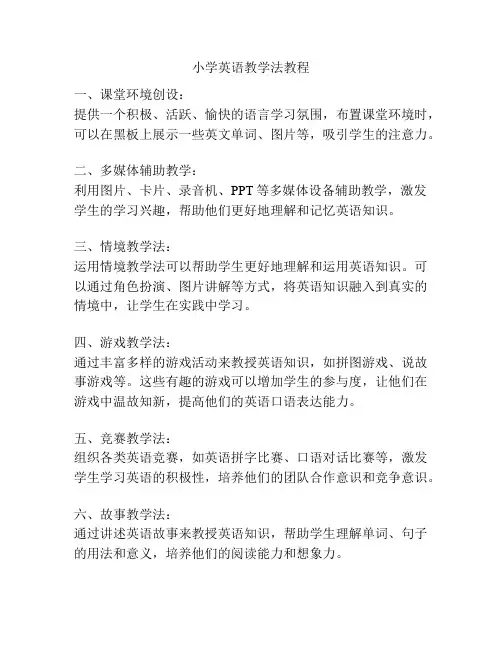
小学英语教学法教程
一、课堂环境创设:
提供一个积极、活跃、愉快的语言学习氛围,布置课堂环境时,可以在黑板上展示一些英文单词、图片等,吸引学生的注意力。
二、多媒体辅助教学:
利用图片、卡片、录音机、PPT等多媒体设备辅助教学,激发学生的学习兴趣,帮助他们更好地理解和记忆英语知识。
三、情境教学法:
运用情境教学法可以帮助学生更好地理解和运用英语知识。
可以通过角色扮演、图片讲解等方式,将英语知识融入到真实的情境中,让学生在实践中学习。
四、游戏教学法:
通过丰富多样的游戏活动来教授英语知识,如拼图游戏、说故事游戏等。
这些有趣的游戏可以增加学生的参与度,让他们在游戏中温故知新,提高他们的英语口语表达能力。
五、竞赛教学法:
组织各类英语竞赛,如英语拼字比赛、口语对话比赛等,激发学生学习英语的积极性,培养他们的团队合作意识和竞争意识。
六、故事教学法:
通过讲述英语故事来教授英语知识,帮助学生理解单词、句子的用法和意义,培养他们的阅读能力和想象力。
七、趣味教学法:
在教学中加入一些趣味元素,如唱歌、跳舞、手工制作等,让学生在轻松愉快的氛围中学习英语,提高他们的学习兴趣和参与度。
八、个别辅导教学法:
根据学生个体差异和学习需求,进行个别辅导,帮助学生解决困惑,巩固学习成果。
以上是一些小学英语教学法的介绍,教师可以根据学生的实际情况和自身教学经验选择适合的教学方法,让学生在轻松愉快的学习氛围中取得更好的学习效果。
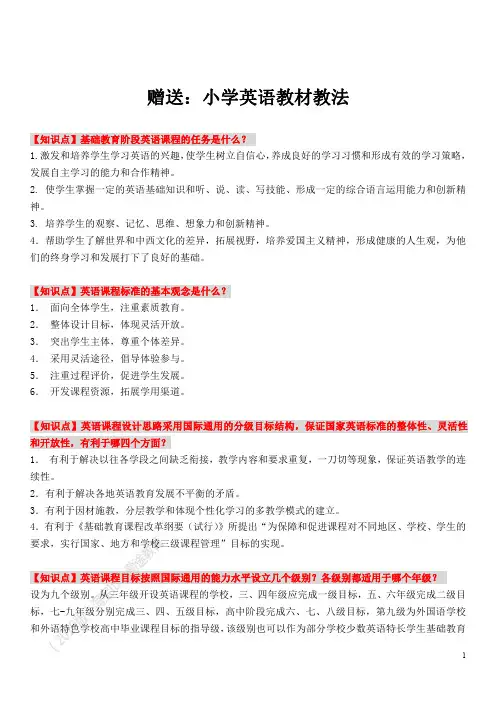
赠送:小学英语教材教法【知识点】基础教育阶段英语课程的任务是什么?1.激发和培养学生学习英语的兴趣,使学生树立自信心,养成良好的学习习惯和形成有效的学习策略,发展自主学习的能力和合作精神。
2.使学生掌握一定的英语基础知识和听、说、读、写技能、形成一定的综合语言运用能力和创新精神。
3.培养学生的观察、记忆、思维、想象力和创新精神。
4.帮助学生了解世界和中西文化的差异,拓展视野,培养爱国主义精神,形成健康的人生观,为他们的终身学习和发展打下了良好的基础。
【知识点】英语课程标准的基本观念是什么?1.面向全体学生,注重素质教育。
2.整体设计目标,体现灵活开放。
3.突出学生主体,尊重个体差异。
4.采用灵活途径,倡导体验参与。
5.注重过程评价,促进学生发展。
6.开发课程资源,拓展学用渠道。
【知识点】英语课程设计思路采用国际通用的分级目标结构,保证国家英语标准的整体性、灵活性和开放性,有利于哪四个方面?1.有利于解决以往各学段之间缺乏衔接,教学内容和要求重复,一刀切等现象,保证英语教学的连续性。
2.有利于解决各地英语教育发展不平衡的矛盾。
3.有利于因材施教,分层教学和体现个性化学习的多教学模式的建立。
4.有利于《基础教育课程改革纲要(试行)》所提出“为保障和促进课程对不同地区、学校、学生的要求,实行国家、地方和学校三级课程管理”目标的实现。
【知识点】英语课程目标按照国际通用的能力水平设立几个级别?各级别都适用于哪个年级?设为九个级别。
从三年级开设英语课程的学校,三、四年级应完成一级目标,五、六年级完成二级目标,七-九年级分别完成三、四、五级目标,高中阶段完成六、七、八级目标,第九级为外国语学校和外语特色学校高中毕业课程目标的指导级,该级别也可以作为部分学校少数英语特长学生基础教育阶段的培养方向。
【知识点】基础教育阶段英语课程的总目标是什么?它建立在哪几个方面的基础上?每个方面都起什么作用?基础教育阶段英语课程的总体目标是:培养学生的综合语言运用能力。
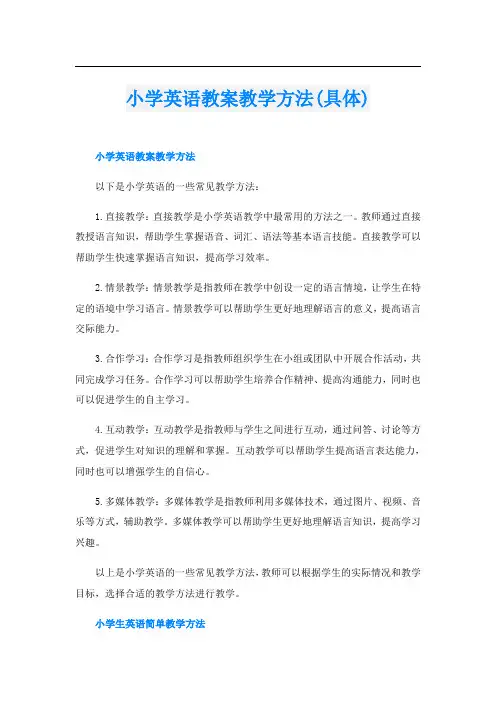
小学英语教案教学方法(具体)小学英语教案教学方法以下是小学英语的一些常见教学方法:1.直接教学:直接教学是小学英语教学中最常用的方法之一。
教师通过直接教授语言知识,帮助学生掌握语音、词汇、语法等基本语言技能。
直接教学可以帮助学生快速掌握语言知识,提高学习效率。
2.情景教学:情景教学是指教师在教学中创设一定的语言情境,让学生在特定的语境中学习语言。
情景教学可以帮助学生更好地理解语言的意义,提高语言交际能力。
3.合作学习:合作学习是指教师组织学生在小组或团队中开展合作活动,共同完成学习任务。
合作学习可以帮助学生培养合作精神、提高沟通能力,同时也可以促进学生的自主学习。
4.互动教学:互动教学是指教师与学生之间进行互动,通过问答、讨论等方式,促进学生对知识的理解和掌握。
互动教学可以帮助学生提高语言表达能力,同时也可以增强学生的自信心。
5.多媒体教学:多媒体教学是指教师利用多媒体技术,通过图片、视频、音乐等方式,辅助教学。
多媒体教学可以帮助学生更好地理解语言知识,提高学习兴趣。
以上是小学英语的一些常见教学方法,教师可以根据学生的实际情况和教学目标,选择合适的教学方法进行教学。
小学生英语简单教学方法以下是几个简单的小学生英语教学方法:1.唱英语歌曲:小学生通常喜欢唱歌,因此唱英语歌曲是一种很好的学习英语的方法。
通过唱英语歌曲,学生可以学习到英语语音、语调、单词和语法,同时也可以提高他们的自信心和兴趣。
2.互动游戏:游戏是孩子们最喜欢的活动之一,因此使用互动游戏来教授英语是一种很好的方法。
例如,可以使用卡片游戏来教授颜色、数字、动物等主题,使用拼图游戏来教授字母、单词等主题。
3.情景模拟:通过情景模拟来教授英语,可以使学习更加生动有趣。
例如,可以通过模拟购物情景来教授购物相关的词汇和短语,通过模拟问路情景来教授问路相关的词汇和短语。
4.TPR教学法:TPR教学法是一种基于身体动作的语言教学法,通过让学生做动作来教授英语。
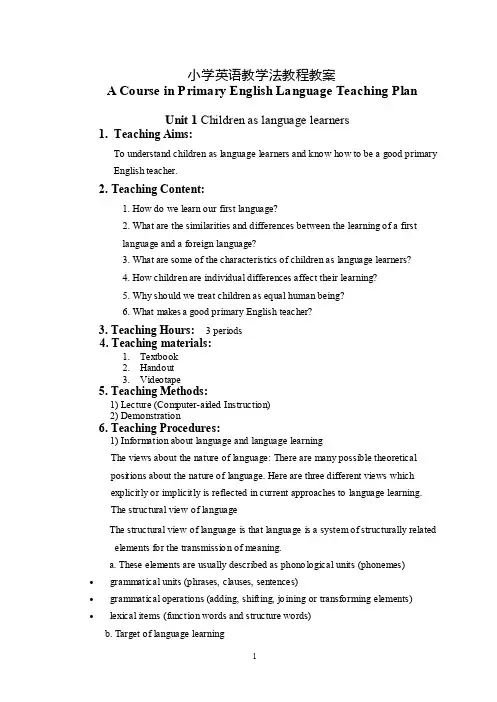
小学英语教学法教程教案A Course in Primary English Language Teaching PlanUnit 1 Children as language learners1.Teaching Aims:To understand children as language learners and know how to be a good primary English teacher.2. Teaching Content:1. How do we learn our first language?2. What are the similarities and differences between the learning of a firstlanguage and a foreign language?3. What are some of the characteristics of children as language learners?4. How children are individual differences affect their learning?5. Why should we treat children as equal human being?6. What makes a good primary English teacher?3. Teaching Hours: 3 periods4. Teaching materials:1.Textbook2.Handout3.Videotape5. Teaching Methods:1) Lecture (Computer-ai ded Instruction)2) Demonstration6. Teaching Procedures:1) Inform ation about language and language learningThe views about the nature of language: There are many possible theoreticalposi tions about the nature of language. Here are three different views whichexplicitly or implicitly is reflected in current approaches to language learning.The structural view of languageThe structural view of language is that language is a system of structurally related elements for the transmissio n of meaning.a. These elements are usually described as phono logical units (phonemes)∙grammatical units (phrases, clauses, sentences)∙grammatical operations (adding, shifting, jo ining or transforming elements)∙lexical items (function words and structure words)b. Target of language learningThe target of language learning, in the structural view, is the mastery of elementsof this system.2) Differences and similarities between learning L1 and L2For L2 learners, the language input is limited. The time spent on learning L2 is much shorter. The learning context is formal and errors are often corrected. Also, the development of the four skills begins almost at the same time. Moreover, L2 learners often do not have the need to communicate in the target languages: therefore, there are few opportunities for pupils to interact except in the classroom and little real context for children to experiment with the language.However, there are some similarities between the learning of L1 and L2. Rich context and input, opportunities for using the language, interaction with others, etc. are important in learning any languages. Teachers should create a nice environment and interesting activities for pupils to use the language to do things.3) Multiple intelligencesDr. Howard Gardner, professor of education at Harvard University, developed the theory of multiple intelligences in 1983.It suggests that everyone has at least seven different intelligences and everyone isdifferent in terms of the intelligences they have.Therefore, teachers need to be aware of the differences and try to help develop eachstudent‘s potentials and learn how to make good use of the theory of multipleintelligences to motivate students in learning.4)Total Physical Response Method:This approach to second language teaching is based on the belief that listening com prehension should be fully developed before any active oral participation from students is expected (just as it is with children when they are learning their native language).7. Homework:1. What are difference between learning the first language and a foreign language?2. What are the qualities of a good language teacher? To what extent have you got these qualities? What do you think you should do so as to become a good teacher in the future?3. What are the qualities of good language learner? What do they suggest to language teaching?8. Self-assessment:Because students are not familiar with these theory on the language and view of the language, it is very difficult to help Ss understand it. So i t requires T explain it in details with the help of clear illustration and examples by using vediotapes. To get students read more on linguistics and schools o f language methods is also necessary.Unit 2 Understanding the National English Curriculum1. Teaching Aims:To discuss one of the most important trends in second/ foreign language teaching in the past three decades, that is the practice of communicative language teaching2. Teaching Content:1) Why is English offered in the primary school?2)What are the objectives for primary English?3) How to understand the requirement of Level 1------2 in the National English Curriculum?3. Teaching Hours: 2 peri ods4. Teaching materials:1) Textbook2) Handout3) Videotape4) Pictures and real objects5. Teaching Methods:1) Lecture (Computer-aided Instruction)2) Demonstration6. Teaching Procedures目前小学英语课程存在的主要困难与问题:1. 对课程的认识尚不统一;重视程度差异大;2. 地区之间、学校之间发展不平衡;3. 师资数量不足,质量急需提高;4. 课堂教学效果需要给予更多关注;5. 评价方式的改革有待进一步深化。
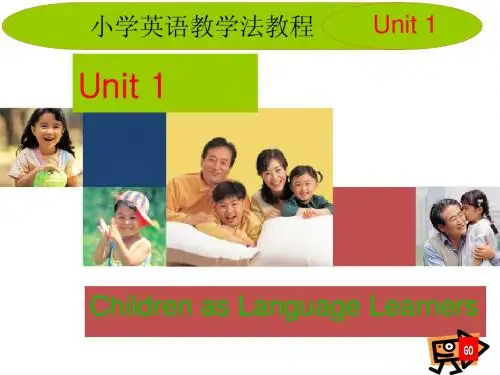
《⼩学英语教学法》《⼩学英语教学法》课程标准⼀、课程基本信息⼆、课程定位与课程设计1.课程定位《⼩学英语教学法》是英语教育专业的⼀门专业核⼼课,是⼀门研究⼩学英语教学⽅法的课程,主要研讨⼩学英语教学中语⾳、词汇、对话、语篇等教学和听、说、读、写的具体教法,并分别提供了相应的教学活动和游戏案例,以及在教学组织时应注意的问题。
《⼩学英语教学法》是研究英语教学规律的科学,本课程旨在提⾼学⽣从事⼩学英语教学的⽔平和教学研究能⼒;并使学⽣能够运⽤本课程所学的理论知识和掌握的教学技能开展⼩学英语教学实践,包括能够根据教学要求设计规范、科学的教学设计;课堂教学能够采⽤合适的教学⽅法、设置多样化的教学活动、运⽤现代化教学⼿段辅助课堂教学等。
该课程在本专业课程体系中占重要地位,并具有较强的综合性和实践性,在培养学⽣从事⼩学英语教师职业所必备的教师专业技能与综合素质、提⾼⼩学英语教学⽔平和教育研究能⼒等⽅⾯具有重要作⽤。
本课程是⼀门综合性应⽤学科,与其他英语专业课及教育学、⼼理学课程都有紧密联系,彼此互相渗透,互相影响。
前导课程是《教育学》、《⼼理学》、《英⽂歌曲》等,并⾏课程是《英语课堂游戏》,后续课程是《幼⼉英语教学法》。
2.课程设计理念:针对英语教育专业的培养⽬标,与⼩学教师资格证考试要求紧密联系,分析英语教育专业职业岗位知识、能⼒、素质结构,以培养学⽣的教师基本功和英语教学能⼒为重点,基于教师岗位的必备技能,开发和设计本课程。
形成“体验,实践,参与,合作与交流”的教学理念。
通过对英语教师所应具备的基本功的规范,对课堂教学常规⼯作的分析,以及对英语教学基本原则、英语教学⽅法的介绍与讲授以及各阶段教学能⼒的课堂模拟训练,让学⽣系统地掌握英语教学⽅法,培养学⽣英语教学的能⼒和驾驭课堂的能⼒。
思路:社会调研→确定课程教学⽬标→确定课程内容→序化教学内容→确定教学模式及教学⽅法→确定考核⽅式。
⑴以英语教师岗位⼈才标准确定课程教学⽬标以英语教师相关岗位能⼒需求为⽬标,本课程在制定教学内容时结合我国⼩学英语教学的情况,针对我国⼩学英语教师教学和学⽣英语学习的实际需要,确定该课程的教学⽬标。
(完整)小学英语教学法教程第二版期末复习知识点,推荐文档《小学英语教学法教程》期末复习知识点Unit1 children as language learners1、How do children acquire their first language in general?(p2)By imitations 、repetitions 、listening to stories ......Discussion point : language learning is a socializing process,interaction and experimenting with the language in communication are important ways for language learning2、What are the differences and similarities between learning L1 and L2?(p6D:the length of time 、opportunities for experimenting with language S:Rich context and input ,opportunities for using the language ,interaction withothers ,etc.are important in learning any languages .3、Children’s characteristics/suggestions for tea chers(p10)4、Ways to nurture children’s motivation (p11五点会判断即可)5、P12 discussion point、p20 1.5.1 (理解、会判断即可)6、How do you understand humanistic education?(p21-22) Humanistic education requires teachers to treat children as human beings who have their own thoughts and needs.Teachers should never try to force their ideas into children’s minds and should always try to think the same level as children.Discussion point : Children need to learn to try new languages andbecome independent learners.7、What is a good primary English teacher like?P24: you should be competent in English ,need to be good at using different teaching techniques which work withchildren ,need to be versatile,need to be able to organize games and activities.P25:need to understand how children think and learn ,need to care for the whole child ,need to help children to develop in an all round way .......A good primary school English teacher need to develop competence in at least three areas :the English language ,the understanding of children ,the techniques and methods for teaching English to children .Unit2 understanding the national English curriculum1、overall aim for English language teaching (p42)(九年制义务教学英语教学目标)AffectLearning strategiesLanguage skillsLanguage knowledgeCultural understanding2、P43小学英语教学阶段目标(三个小黑点部分)Unit 3 classroom management1、What is classroom management?(p65)Classroom management refers to the way teachers organize whathappens in the classroom .2、What influence children’s learning? (p65)Attitudes and motivation3、Two kinds of motivations(p66)Intrinsic and extrinsic motivations4、Some good ideas for motivating children in learning English (p69-70)5、Lesson planning (p71)Reasons p71-72 (a-l)Advantages p71 discussion point (第一段)first of all, ,moreover, ,thirdly, ,last,6、Principles of lesson planning (p76)(1)clear aims or objectives(2)enough variety(3)with flexibility7、Why don’t we teach children in English?(p79 三个小黑点部分)8、Five steps towards better instructions (p82)9、Types of question classification(p87)Closed and open questionsDisplay and genuine questionsLower-order and higher-order questions10、Some tips for engaging pupils to ask questions in class (p89-90)11、Some suggestions on creating good learning atmosphere(p94小黑点部分)12、P95 discussion point(教师备课时应考虑的因素(小黑点部分)、课堂中有学生制造麻烦时可以采取的办法(1)-(6))13、Teaching large classes大班教学Problems:p98 discussion point14、Four forms of interactions (p100)Whole class workPair workGroup workIndividual study15、Activitiesstirring and settling activities(p108)physically-engaged and mentally-engaged activities(p110)16、We should think about three phases of an activity when we organize it. (111)The preparation phase,the main activity phase,the follow-up or consolidation phase17、the differences between an error and a mistake(p115)A mistake refers to a performance error that is either a random guess or a “slip of tongue”,and it is a failure performance to a known system .A mistake has nothing to do with the language competence, it results fromcarelessness or temporary breakdown and it can be self-corrected.An error has direct relation with the learners’language competence,it results from the lack of knowledge in the target language and it can’t be self-corrected .Unit4 teaching vocabulary ,grammar and pronunciation1、p129 In most beginning level primary English text books,vocabulary is often presented with pictures and illustrations.2、What does knowing a word involve?(p130)Word meaning ( meaning in context ,some relations)Word use(metaphor and idiom,collocation,style and register) Word information(parts of speech,prefixes and suffixes,spelling and pronunciation)Word grammar (noun:countable/uncountable,verb complementation/ phrasal verbs,etc,adjectives and adverbs ,position,etc.(p130 discussion point 是对上面的解释)3、What methods/techniques can be used to present new words?(p131)Using real objectsUsing pictures or illustrationsProviding demonstration or giving examplesInvolving learners in actionsP133 An important principle that we should bear in mind is that “studentsneed to see words in context to see how they are used”.In other words,they need to “see or hear those words in action”.Therefore,the best way to present new words is to provide a meaningful context and give children the chance to observe,to think ,to act.4、What activities can be used for practicing vocabulary?(p133-134) Look and match,Listen and point,The odd one out/which one is different? Put the words into boxes,Tape recorder,Bingo game5、p135 discussion point 第三段Cameron and Nation 两个人的观点6、Principles in teaching grammar p138四个小黑点部分7、How should grammar be presented? p138-139deductive (演绎)or inductive(归纳)P139 两个例子分别是演绎法和归纳法的教学,要会判断这两种方法。
小学英语教学方法小学英语教学方法一、游戏教学法用游戏形式复习单词、句型,练习新语言点。
使学生寓学于乐,在活泼、轻松、愉快的气氛中自然而然科学知识地获得英语知识与技能。
游戏要求简短易行,有趣味性,而且要与授课教学内容紧密英语教学相应。
我在课堂上经常用到以下游戏解题来巩固复习单词、句型等:1. 吹气球 blow the balloons 游戏说明:学生边说单词边做吹气球刮的动作,声音随着气球的大小发生相应的涨落。
2. 大小声 opposite tune 游戏说明:学生与教师进行唱反调的游戏,教师声音大,学生声音小;教师声音小,学生的声音则大。
3. 木头人 wooden child 游戏说明:学生或选一名学生背对学生们进行单词操练,当教师或学生转过身时其他学生保持原来的动作变成木头人。
4. 传话 whisper 游戏说明:分组游戏,两组同学传各不相同的句子,看哪组传的又快又好,可以进行奖励。
5. 背靠背 back to back 游戏说明:给参加游戏的孩子在后背贴上单词或者图片,当孩子转过身来时,谁先说出对方的单词谁取得成功取得胜利。
6. 五体投地 body 游戏说明:把单词卡片放在地上,然后用身体的各个前臂去接触。
7. 过山车 get on the train 游戏说明:学生们手拉手围成圈边走边说要操练的单词或者句型,老师和一个圈里的学生手撑手刺破哪个学生,学生需说出所操练的单词师生或疑问句。
8. 谁最快 Who is the best 游戏说明:在全班整体操练单词津门虎的时候,教师说one two go,教师手中副本如果教师是平放的,学生就坐着说单词,如果卡片是立起来放的,学生就站起来说,看谁反应最快。
9. 跳一跳 jump and say 游戏说明:把学过的单词贴纸在黑板上,然后两三个人一组,教师说到哪个单词的时候,教师就跳向哪个单词,并把它读出来,看谁最快。
10. 抢椅子 get the chair 游戏说明:教师在教室前面竖几个阶梯教室椅子,然后叫小朋友到前面来,教师和学生一起读要操练的单词或句型,当教师停下来的时候学生茶几就要去抢椅子,没再读抢到的学生就行了被罚读一个单词,然后out。